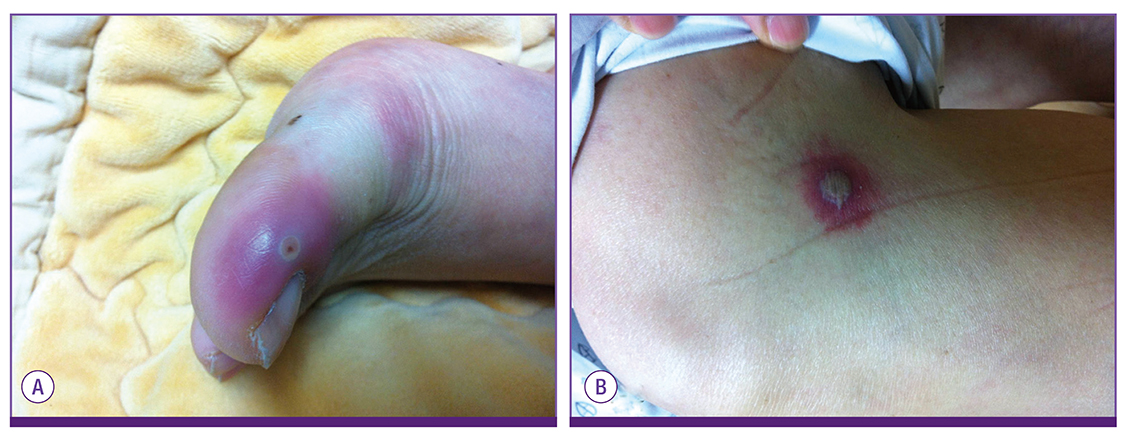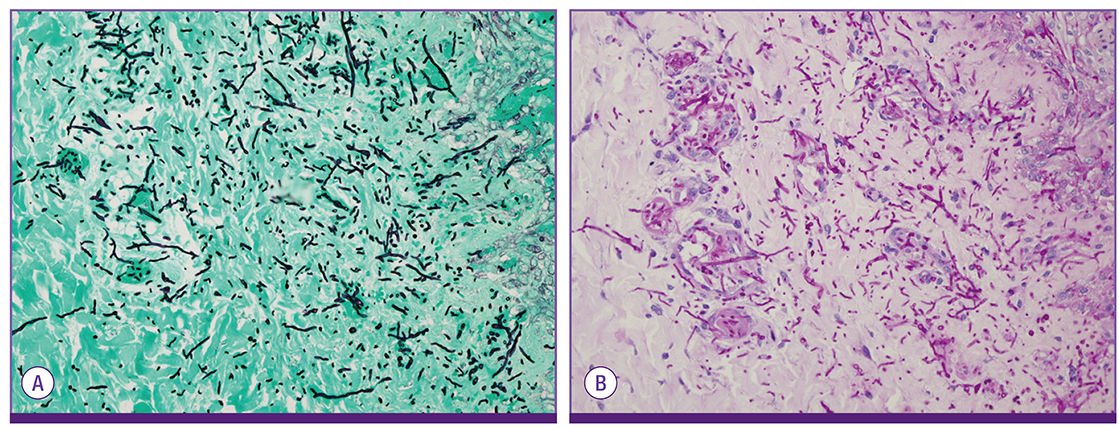Infect Chemother.
2017 Jun;49(2):142-145. 10.3947/ic.2017.49.2.142.
A Case of Disseminated Infection with Skin Manifestation due to Non-neoformans and Non-gattii Cryptococcus in a Patient with Refractory Acute Myeloid Leukemia
- Affiliations
-
- 1Department of Internal Medicine, National Cancer Center, Goyang, Korea.
- 2Hematologic Oncology Clinic, National Cancer Center, Goyang, Korea. hseom@ncc.re.kr
- 3Department of Pathology, National Cancer Center, Goyang, Korea.
- 4Department of Laboratory Medicine, National Cancer Center, Goyang, Korea.
- 5Infectious Disease Clinic, National Cancer Center, Goyang, Korea.
- KMID: 2383937
- DOI: http://doi.org/10.3947/ic.2017.49.2.142
Abstract
- Cryptococcus spp. other than Cryptococcus neoformans or Cryptococcus gattii were previously considered saprophytes and thought to be non-pathogenic to humans. However, opportunistic infections associated with non-neoformans and non-gattii species, such as Cryptococcus laurentii and Cryptococcus albidus, have increased over the past four decades. We experienced a case of cryptococcosis caused by non-neoformans and non-gattii spp. in a 47-year-old female with refractory acute myeloid leukemia after allogeneic hematopoietic stem cell transplantation. The patient underwent salvage chemotherapy with fluconazole prophylaxis and subsequently developed neutropenic fever with multiple erythematous umbilicated papules. A skin biopsy revealed fungal hyphae and repetitive blood cultures showed yeast microorganisms that were identified later as C. laurentii by Vitek-II®. Skin lesions and fever began to improve with conventional amphotericin B therapy. The treatment regimen was continued for 21 days until the disseminated cryptococcosis was completely controlled.
MeSH Terms
Figure
Reference
-
1. Khawcharoenporn T, Apisarnthanarak A, Mundy LM. Non-neoformans cryptococcal infections: a systematic review. Infection. 2007; 35:51–58.2. Shankar EM, Kumarasamy N, Bella D, Renuka S, Kownhar H, Suniti S, Rajan R, Rao UA. Pneumonia and pleural effusion due to Cryptococcus laurentii in a clinically proven case of AIDS. Can Respir J. 2006; 13:275–278.
Article3. Cheng MF, Chiou CC, Liu YC, Wang HZ, Hsieh KS. Cryptococcus laurentii fungemia in a premature neonate. J Clin Microbiol. 2001; 39:1608–1611.
Article4. Gupta RK, Khan ZU, Nampoory MR, Mikhail MM, Johny KV. Cutaneous cryptococcosis in a diabetic renal transplant recipient. J Med Microbiol. 2004; 53:445–449.
Article5. Chand-Goyal T, Spotts RA. Enumeration of bacterial and yeast colonists of apple fruits and identification of epiphytic yeasts on pear fruits in the Pacific Northwest United States. Microbiol Res. 1996; 151:427–432.
Article6. Johnson LB, Bradley SF, Kauffman CA. Fungaemia due to Cryptococcus laurentii and a review of non-neoformans cryptococcaemia. Mycoses. 1998; 41:277–280.
Article7. Lin J, Idnurm A, Lin X. Morphology and its underlying genetic regulation impact the interaction between Cryptococcus neoformans and its hosts. Med Mycol. 2015; 53:493–504.
Article8. Magditch DA, Liu TB, Xue C, Idnurm A. DNA mutations mediate microevolution between host-adapted forms of the pathogenic fungus Cryptococcus neoformans . PLoS Pathog. 2012; 8:e1002936.9. Walton FJ, Heitman J, Idnurm A. Conserved elements of the RAM signaling pathway establish cell polarity in the basidiomycete Cryptococcus neoformans in a divergent fashion from other fungi. Mol Biol Cell. 2006; 17:3768–3780.
Article10. Kulkarni A, Sinha M, Anandh U. Primary cutaneous cryptococcosis due to Cryptococcous laurentii in a renal transplant recipient. Saudi J Kidney Dis Transpl. 2012; 23:102–105.11. Saag MS, Graybill RJ, Larsen RA, Pappas PG, Perfect JR, Powderly WG, Sobel JD, Dismukes WE. Practice guidelines for the management of cryptococcal disease. Clin Infect Dis. 2000; 30:710–718.
Article12. Husain S, Wagener MM, Singh N. Cryptococcus neoformans infection in organ transplant recipients: variables influencing clinical characteristics and outcome. Emerg Infect Dis. 2001; 7:375–381.
Article
- Full Text Links
- Actions
-
Cited
- CITED
-
- Close
- Share
- Similar articles
-
- Genotypes of Clinical and Environmental Isolates of Cryptococcus neoformans and Cryptococcus gattii in Korea
- Cryptococcus Species Infection in a Bone Marrow Transplant Patient and Review of the Literature
- A Case of Cryptococcal Osteomyelitis with Paraspinal Abscess
- Cutaneous Manifestation of Disseminated Cryptococcosis Mimicking Herpes Zoster
- A Case of Cutaneous Cryptococcosis Resembling Pyoderma Gangrenosum



